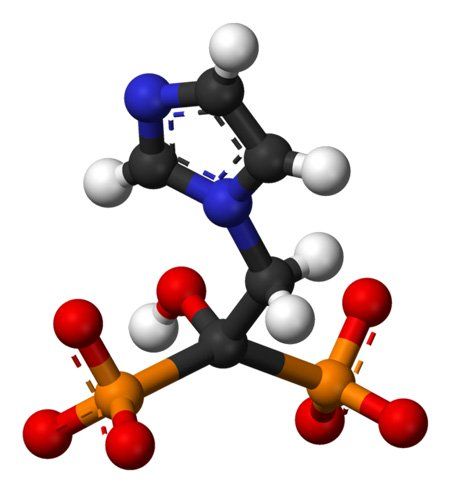Less Frequent Zoledronic Acid OK in Breast Cancer Patients With Bone Mets
Zoledronic acid given every 12 weeks was just as efficacious as the drug administered at the standard dosing schedule of every 4 weeks for breast cancer patients with bone metastases.
Ball-and-stick model of zoledronic acid

Zoledronic acid given every 12 weeks was just as efficacious as the drug administered at the standard dosing schedule of every 4 weeks for breast cancer patients with bone metastases. The results (abstract LBA9500) of the phase III OPTIMIZE-2 trial were presented by Gabriel N. Hortobagyi, MD, of the department of breast medical oncology at MD Anderson Cancer Center in Houston, at the American Society of Clinical Oncology Annual Meeting, held May 30–June 3 in Chicago.
The rate of skeletal-related events (SREs) was similar in both treatment arms-22% in the every 4 week arm and 23.2% in the every 12 week arm (P = .724). The time to first on-study SRE and the mean skeletal morbidity rates (SMRs) were also similar for both treatment arms (P = .792 and P = .854, respectively).
“Less frequent ‘maintenance therapy’ with zoledronic acid at 12-week intervals is more convenient, less expensive, similarly effective, and probably less toxic,” Hortobagyi told Cancer Network. “Therefore, [this dosing schedule] should be preferred.”
Currently, zoledronic acid, a bisphosphonate, is administered every 4 weeks as an intravenous (IV) infusion in order to reduce the risk of SREs in patients whose disease has progressed to bone tissue.
“The important finding is that we do not need our patients with bone metastasis from breast cancer to come in monthly for zoledronic acid,” said Don S. Dizon, MD, a gynecologic cancer clinician and researcher at Massachusetts General Hospital Cancer Center in Boston, who was not involved in the study. “That it is safe to give therapy every 12 weeks will be welcomed.”
The trial randomized 403 advanced breast cancer patients with bone metastases who had previously received at least nine doses of a bisphosphonate (either zoledronic acid or pamidronate) during their first 10 to 15 months of therapy. The patients received zoledronic acid as a 4-mg IV dose either every 4 weeks or every 12 weeks for an additional year. The median age of the patients was 59 years.
Treatment-related adverse events were similar in both study arms, although there were numerically more renal adverse events reported in the arm that received the treatment more frequently (9.6% compared with 7.9%, respectively). There were two cases (1.0%) of osteonecrosis of the jaw (reported in the every 4 week dose arm).
Because zoledronic acid given every 4 weeks results in the higher probability of a patient developing a rare but potentially serious complication, such as kidney dysfunction, osteonecrosis of the jaw, or atypical midshaft fractures of long bones, the study investigators wanted to test whether a less frequent administration would reduce such risks but not affect the efficacy of the drug.
According to Dizon, these results may be practice-changing, although he noted that further follow-up of patients on the trial may be necessary since the endpoint reported was the skeletal-related event rate at 1 year. “Still, these data suggest there’s no gain for patients with more frequent treatment,” Dizon told Cancer Network. “Less often [treatment] is effective, and likely is a reasonable option to discuss with patients now.”
Whether an every 4 week dosing regimen of zoledronic acid is necessary at the time of bone metastasis diagnosis or whether a longer time between treatments would be sufficient for breast cancer patients remains an open question. “These data raise the possible hypothesis that treatment [with zoledronic acid] every 12 weeks might be safe from an even earlier initiation point,” said Dizon.
According to Hortobagyi, these results probably apply to subsequent years of zoledronic acid therapy, and could potentially be extrapolated to other types of cancer that produce bone metastases.